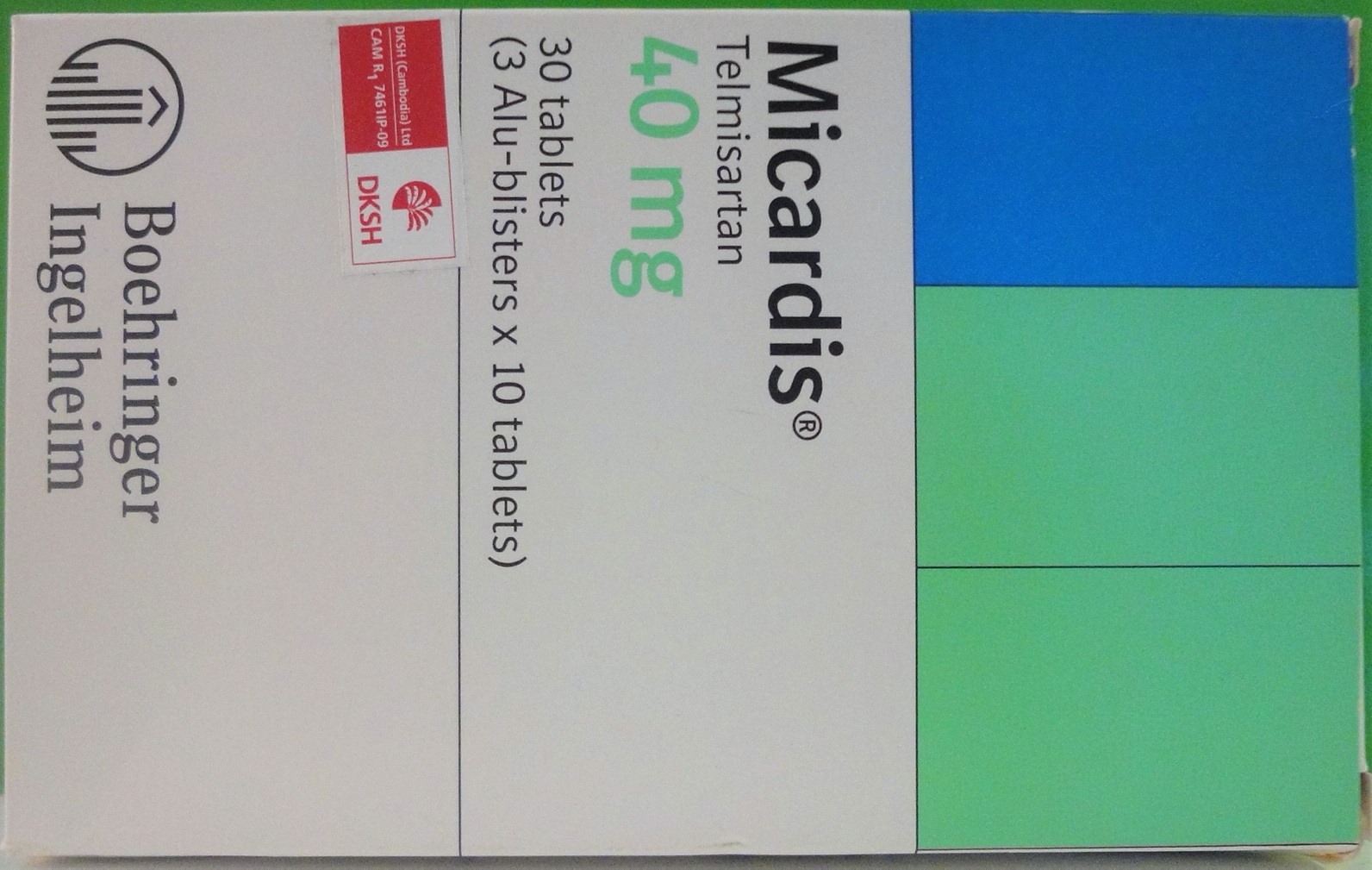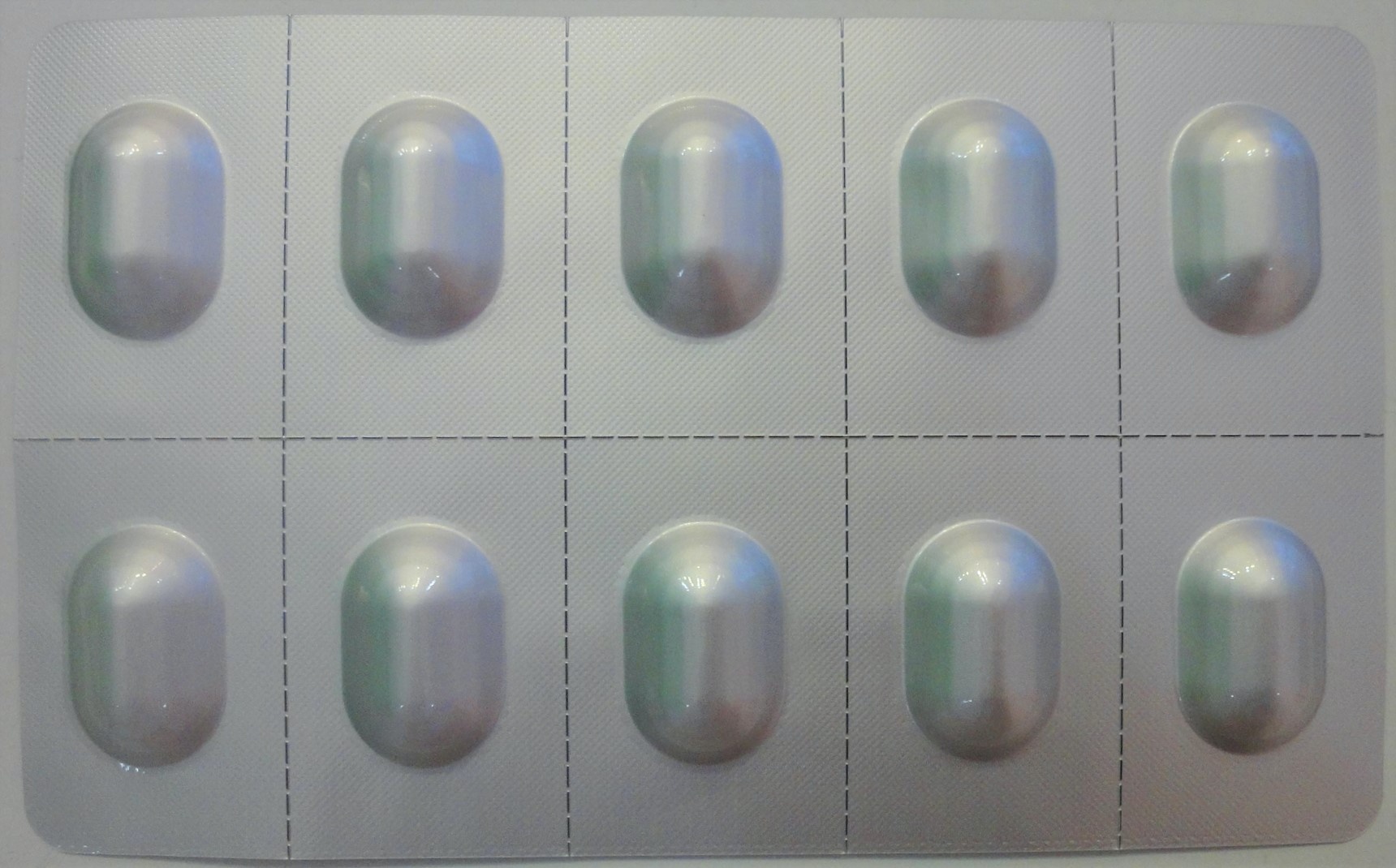MICARDIS Tablet
ក្រុមហ៊ុនផលិតឱសថ:
Boehringer Ingelheim Ellas A.E, Greece
ក្រុមហ៊ុនចែកចាយឱសថនៅប្រទេសកម្ពុជា:
DKSH


- សារធាតុសកម្ម
- ប្រសិទ្ធិភាពព្យាបាល និង កម្រិតប្រើប្រាស់
- ហាមប្រើ
- ផលរំខាន
- អន្តរប្រតិកម្ម
- ស្ត្រីមានផ្ទៃពោះ និង ស្ត្រីបំបៅដោះកូន
- ការប្រុងប្រយ័ត្នជាពិសេស
- សកម្មភាពឱសថ បរិយាយប័ណ្ណឱសថ
-
សារធាតុសកម្ម
-
ប្រសិទ្ធិភាពព្យាបាល និង កម្រិតប្រើប្រាស់
គុណភាពព្យាបាល
ជាប្រភេទឱសថនេះក្រុម Sartan សំរាប់ព្យាបាល: ជម្ងឺសម្ពាធឈាមឡើង។
កំរិតនិងរបៀបប្រើ
- ឱសថនេះអាចប្រើជាមួយអាហារ ឬ មុននិងក្រោយស្រស់ស្រូបអាហារ។
- មនុស្សពេញវ័យ: ប្រើ40ម.ក្រ ក្នុង1ថ្ងៃ អ្នកជម្ងឺខ្លះប្រើតែ 20ម.ក្រក្នុង1ថ្ងៃ។
- កំរិតអតិបរមា: 80ម.ក្រក្នុង1ថ្ងៃ (ប្រើតែម្ដង) ប្រសិនបើសម្ពាធឈាមមិនចុះថយ។
- ឱសថនេះអាចប្រើជាមួយពពួកឱសថបញ្ចុះទឹកនោមបានដូចជា Hydrochlorothiazide ដើម្បីអោយសម្ពាធឈាមចុះថយ។
- ករណីអ្នកជម្ងឺសម្ពាធឈាមឡើងធ្ងន់ធ្ងរ: កំរិតប្រើតែឯងអាចកើនឡើងដល់ 160ម.ក្រ ហើយប្រើរួមជាមួយ Hydrochlorothiazide ពី 12.5ម.ក្រ ទៅ 25ម.ក្រ ក្នុង1ថ្ងៃ។
- អ្នកជម្ងឺខ្សោយថ្លើម: កំរិតប្រើមិនត្រូវលើសពី 40ម.ក្រ ក្នុង1ថ្ងៃទេ។Dosage and administration (see the package insert about details.)
Adults
Treatment of essential hypertension
20-40mg once daily.
Maximum dose: 80mg
Alternatively, Telmisartan may be used in combination with thiazide-type diuretics such as hydrochlorothiazide, which has been shown to have an additive blood pressure lowering effect with telmisartan. When considering raising the dose, it must be borne in mind that the maximum antihypertensive effects is generally attained 4-8 weeks after the start of treatment.
In patients with severe hypertension treatment with telmisartan at doses up to 160mg alone and in combination with hydrochlorothiazide 12.5-25 mg daily was well tolerated and effective.
Prevention of cardiovascular morbidity and mortality
80mg once daily.
When initiating telmisartan therapy monitoring of blood pressure is recommended, and if appropriate adjustment of medications that lower blood pressure may be necessary.
MICARDIS may be taken with or without food.
Renal impairment
No posology adjustment is required for patients with renal impairment, including those on haemodialysis.
Telmisartan is not removed from blood by hemofiltration.
Hepatic impairment
In patients with mild to moderate hepatic impairment the posology should not exceed 40mg once daily.
Elderly
No dosing adjustment is necessary.
Children and adolescents
The safety and efficacy for use in children below 18 years have not been established.
-
ហាមប្រើ
ហាមប្រើ៖
- អ្នកជម្ងឺងាយមានប្រតិកម្មជាមួយសារធាតុផ្សំណាមួយនៃឱសថនេះ
- ស្ត្រីបំបៅកូន ស្ត្រីមានផ្ទៃបោះ នៅត្រីមាសទី2និងទី3
- វិបត្តិស្ទះទឹកប្រមាត់
- ខ្សោយថ្លើមធ្ងន់ធ្ងរ។- Hypersensitivity to the active ingredient or any of the excipients
- Second and third trimesters of pregnancy
- Lactation
- Biliary obstructive disorders
- Severe hepatic impairment
- The concomitant use with aliskiren is contraindicated in patients with diabetes mellitus or renal impairment (GFR<60ml/min/1.73m2)
In case of rare hereditary conditions that may be incompatible with an excipient of the product
-
ផលរំខាន
ផលរំខានខ្លះៗ៖
- ការឆ្លងរោគ និងការឆ្លងប៉ារ៉ាស៊ីតច្រើន ជម្ងឺឆ្លងផ្លូវភេទ (រលាកប្លោកនោម) ជម្ងឺផ្លូវដង្ហើមផ្នែកខាងលើ
- វិបត្តិផ្លូវចិត្ត: ការកង្វល់
- វិបត្តិភ្នែក: វិបត្តិគំហើញ
- វិបត្តិត្រចៀកនិងរន្ធត្រចៀកខាងក្នុង: វិលមុខ
- វិបត្តិក្រពះពោះវៀន: ឈឺពោះ រាក ស្ងួតមាត់ ពិបាករំលាយអាហារ ហើមពោះ ឈឺក្រពះ
- វិបត្តិស្បែកនិងជាលិកាទន់: ត្រអក ចេញញើសច្រើន
- វិបត្តិសាច់ដុំ និងគំរោងឆ្អឹង: ឈឺសន្លាក់ដៃឬជើង ឈឺខ្នង រមួលសាច់ដុំជើង ឬឈឺចាប់ជើង ឈឺសាច់ដុំដូចជារលាកសរសៃពួរ
- វិបត្តិទូទៅ : ឈឺទ្រូង ផ្ដាសាយធំ ករណីខ្លះបណ្ដាលអោយកើតមាន ចេញកន្ទួលក្រហមលើស្បែក រមាស់ស្បែកខ្លាំង ខ្យល់គ ឬចុះខ្សោយ ដេកមិនលក់ ធ្លាក់ទឹកចិត្ត ចង្អោរ សម្ពាធឈាមចុះនៅពេលក្រោកឈរម្ដងៗ ចង្វាក់បេះដូងដើរយឺត ដើរលឿន មុខងារថ្លើមប្រែប្រួល ខ្សោយតម្រងនោមស្រួចស្រាវ ឡើងជាតិប៉ូតាស្យូមក្នុងឈាម ថប់ដង្ហើម ស្លេកស្លាំង ប្លាកែតក្នុងឈាមថយចុះ ចុះខ្សោយសុខភាព
- ផលរំខានខ្លះទៀតដែលកើតមានក្រៅពីរៀបរាប់ខាងលើនេះ ត្រូវពិគ្រោះជាមួយគ្រូពេទ្យ។
- ការប្រើលើសកំរិត: សម្ពាធឈាមចុះនិងចង្វាក់បេះដូងដើរលឿន ចង្វាក់បេះដូងដើរយឺត កើតមានត្រូវធ្វើការព្យាបាលភ្លាម។Infections and infestations
Sepsis including fatal outcome, urinary tract infections (including cystitis), upper respiratory tract infections
Blood and lymphatic system disorders:
Anaemia, eosinophilia, thrombocytopenia
Immune system disorders:
Anaphylactic reaction, hypersensitivity
Metabolism and nutrition disorders:
Hyperkalaemia, hypoglycaemia (in diabetic patients)
Psychiatric disorders
Anxiety, insomnia, depression
Nervous system disorders:
Syncope (faint)
Eye disorders
Visual disturbance
Ear and labyrinth disorders
Vertigo
Cardiac disorders:
Bradycardia, tachycardia
Vascular disorders:
Hypotension, orthostatic hypotension
Respiratory disorders:
Dyspnoea
Gastro-intestinal disorders:
Abdominal pain, diarrhoea, dry mouth, dyspepsia, flatulence, stomach discomfort, vomiting
Hepatobiliary disorders:
Hepatic function abnormal / liver disorder
Skin and subcutaneous tissue disorders:
Angioedema (with fatal outcome), eczema, erythema, pruritus, hyperhidrosis, urticaria, drug eruption, toxic skin eruption, rash
Musculoskeletal, connective tissue and bone disorders:
Arthralgia, back pain, muscle spasms (cramps in legs), pain in extremity (leg pain), myalgia, tendon pain (tendinitis like symptoms).
Renal and urinary tract disorders:
Renal impairment including acute renal failure
General disorders and administration site conditions:
Chest pain, influenza-like illness, asthenia (weakness)
Investigations:
Haemoglobin decreased, blood uric and increased, blood creatinine increased, hepatic enzymes increased, blood creatinine phosphokinase (CPK) increased
-
អន្តរប្រតិកម្ម
អន្តរកម្មឱសថ - ការប្រើឱសថនេះជាមួយឱសថប្រឆាំងសម្ពាធឈាមឡើង អាចបង្កើនប្រសិទ្ធភាពសម្ពាធឈាមចុះ - ប្រើរួមជាមួយ digoxin, warfarin, hydrochlorothiazide, glibenclamide, ibuprofen, paracetamol, simvastation និង amlodipine ពុំមានផលប៉ះពាល់ក្នុងការព្យាបាលឡើយ
- ប្រើរួមជាមួយ NSAIDs អាចកាត់បន្ថយប្រសិទ្ធភាពនៃការបញ្ចុះសម្ពាធឈាម។(See package insert about details.)
MICARDIS may increase the hypotensive effect of other antihypertensive agents. Other interactions of clinical significance have not been identified.
Digoxin
Ramipril and ramiprilat.
Lithium.
NSAIDs.
-
ស្ត្រីមានផ្ទៃពោះ និង ស្ត្រីបំបៅដោះកូន
Pregnancy
AngiotensinⅡreceptor antagonists should not be initiated during pregnancy.
Unless continued angiotensinⅡreceptor antagonist therapy is considered essential, patients planning pregnancy should be changed to alternative anti-hypertensive treatments which have an established safety profile for use in pregnancy.
When pregnancy is diagnosed, treatment with angiotensinⅡreceptor antagonists should be stopped immediately, and if appropriate, alternative therapy should be started.
The use of angiotensinⅡreceptor antagonists is not recommended during the first trimester of pregnancy and should not be initiated during pregnancy. When pregnancy is diagnosed, treatment with angiotensinⅡreceptor antagonists should be stopped immediately, and, if appropriate, alternative therapy should be started.
The use of angiotensinⅡreceptor antagonists is contraindicated during the second and third trimester of pregnancy.
Non-clinical studies with telmisartan do not indicate teratogenic effect, but have shown fetotoxicity.
AngiotensinⅡreceptor antagonists exposure during the second and third trimesters is known to induce human fetetoxicity (decreased renal function, oligohydramnios, skull ossification retardation) and neonatal toxicity (renal failure, hypotension, hyperkalaemia).
Unless continued angiotensinⅡreceptor antagonist therapy is considered essential, patients planning pregnancy should be changed to alternative anti-hypertensive treatments which have an established safety profile for use in pregnancy. When pregnancy is diagnosed, treatment with angiotensinⅡreceptor antagonists should be stopped immediately, and, if appropriate, alternative therapy should be started.
Should exposure to angiotensinⅡreceptor antagonists have occurred from the second trimester of pregnancy, ultrasound check of renal function and skull is recommended.
Infants whose mothers have taken angiotensinⅡreceptor antagonists should be closely observed for hypotension.
MICARDIS is contraindicated during lactation since it is not known whether it is excreted in human milk. Animal studies have shown excretion of telmisartan in breast milk.
-
ការប្រុងប្រយ័ត្នជាពិសេស
ការប្រុងប្រយ័ត្ន៖ ចំពោះ
- Renovascular hypertension អាចបណ្ដាលអោយសម្ពាធឈាមចុះ និងខ្សោយតម្រងនោម
- ចំពោះអ្នកជម្ងឺស្ទះសរសៃឈាមក្រហមនៅប្លោកនោម និងសរសៃអាកទែរ
- ការវះកាត់ប្ដូរតម្រងនោម ប្លោកនោម អ្នកជម្ងឺខ្សោយមុខងារតម្រងនោម និង អ្នកធ្វើការវះកាត់ផ្លាស់ប្ដូរតម្រងនោមនិងប្លោកនោម
- ការបាត់បង់ជាតិទឹកពីក្នុងខ្លួន (Intravascular volume depletion)
- ជម្ងឺស្ទះប្រើសបិទ បើកសរសៃឈាម អារអក និង មីត្រាលស្ទះដោយសាររីកសាច់ដុំបេះដូង
- ជាតិប៉ូតាស្យូមកើនឡើងពេលប្រើឱសថនេះRenovascular hypertension
There is an increased risk of severe hypotension and renal insufficiency when patients with bilateral renal artery stenosis or stenosis of the artery to a single functioning kidney are treated with medicinal products that affect the renin-angiotensin-aldosterone system.
Renal impairment and kidney transplant
When MICARDIS is used in patients with impaired renal function, a periodic monitoring of potassium and creatinine serum levels is recommended. There is no experience regarding the administration of MICARDIS in patients with a recent kidney transplant.
Intravascular volume depletion
Symptomatic hypotension, especially after the first dose, may occur in patients who are volume and/or sodium depleted by vigorous diuretic therapy, dietary salt restriction, diarrhoea or vomiting. Such conditions, espially volume and/or sodium depletion, should be corrected before the administration of MICARDIS.
Dual blockage of the renin-angiotensin-aldosterone system:
As a consequence of inhibiting the renin-angiotensin-aldosterone system changes in renal function (including acute renal failure) have been reported in susceptible individuals. especially if combining medicinal products that affect this system. Dual blockade of the renin-angiotensin-aldosterone system (e.g. by adding an ACE-inhibitor or the direct renin-inhibitor aliskiren to an angiotensinⅡreceptor antagonist) should therefore be limited to individually defined cases with close monitoring of renal function.
Other conditions with stimulation of the renin-angiotensin-aldosterone system
In patients whose vascular tone and renal function depend predominantly on the activity of the renin-angiotensin-aldosterone system (e.g. patients with severe congestive heart failure or underlying renal disease, including renal artery stenosis), treatment with medicinal products that affect this system has been associated with acute hypotension, hyperazotaemia, oliguria, or rarely acute renal failure.
Primary aldosteronism
Patients with primary aldosteronism generally will not respond to antihypertensive medicinal products acting through inhibition of the renin-angiotensin system. Therefore, the use of MICARDIS is not recommended.
Aortic and mitral valve stenosis, obstructive hypertrophic Cardiomyopathy
As with other vasodilators, special caution is indicated in patients suffering from aortic or mitral stenosis, or obstructive hypertrophic cardiomyopathy.
Hyperkalaemia
During treatment with medicinal products that affect the renin-angiotensin-aldosterone system hyperkalaemia may occur, especially in the presence of renal impairment and/or heart failure. Monitoring of serum potassium in patients at risk is recommended. Based on experience with the use of medicinal products that affect the renin-angiotensin system, concomitant use with potassium-sparing diuretics, potassium supplements, salt substitutes containing potassium or other medicinal products that may increase the potassium level (heparin, etc.) may lead to an increase in serum potassium and should therefore be co-administered cautiously with MICARDIS.
Hepatic impairment
Telmisartan is mostly eliminated in the bile. Patients with biliary obstructive disorders or hepatic insufficiency can be expected to have reduced clearance.
Sorbitol
This product contains 338mg of sorbitol per maximum recommended daily dose. Patients with the rare hereditary condition of fructose intolerance should not take this medicine.
Diabetes mellitus
In diabetic patients with an additional cardiovascular risk, i.e. patients with diabetes mellitus and coexistent coronary artery disease (CAD), the risk of fatal myocardial infarction and unexpected cardiovascular death may be increased when treated with blood pressure lowering agents such as ARBs or ACE-inhibitors. In patients with diabetes mellitus CAD may be asymptomatic and therefore undiagnosed. Patients with diabetes mellitus should undergo appropriate diagnostic evaluation, e.g. exercise stress testing, to detect and to treat CAD accordingly before initiating treatment with MICARDIS.
Other
As observed for angiotensin converting enzyme inhibitors, angiotensin receptor blockers including MICARDIS are apparently less effective in lowering blood pressure in black people than in non-blacks, possibly because of higher prevalence of low-renin states in the black hypertensive population.
As with any antihypertensive agent, excessive reduction of blood pressure in patients with inchaemic cardiopathy or ischaemic cardiovascular disease could result in a myocardial infarction or stroke.
-
សកម្មភាពឱសថ
Telmisartan is an orally effective and specific angiotensinⅡreceptor (type AT1) antagonist. Telmisartan displaces angiotensinⅡwith very high affinity from its binding site at the AT1 receptor subtype, which is responsible for the known actions of angiotensinⅡ.
*ព័ត៌មានឱសថត្រូវបានរៀបរៀងដោយ អ៊ីម៉ាតុគឹ មេឌីក (ខេមបូឌា) ដោយផ្អែកលើប្រភពព័ត៌មានខាងក្រោម។ សម្រាប់ព័ត៌មានលម្អិត សូមស្វែងរកនៅក្នុងក្រដាសព័ត៌មាននៃឱសថនីមួយៗ ឬ សាកសួរទៅកាន់ក្រុមហ៊ុនឱសថឬតំណាងចែកចាយនៃឱសថនីមួយៗ។
ប្រភពព័ត៌មាន៖
- ក្រដាសព័ត៌មាននៃឱសថសម្រាប់អ្នកជំនាញវេជ្ជសាស្ត្រដែលប្រើប្រាស់នៅប្រទេសជប៉ុន (Pharmaceutical and Medical Devices Agency, Pmda): https://www.pmda.go.jp
- ព័ត៌មានសង្ខេបនៃឱសថសម្រាប់អ្នកជំងឺដែលប្រើប្រាស់នៅប្រទេសជប៉ុន: http://www.rad-ar.or.jp
